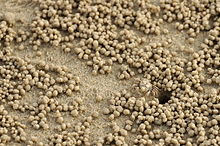- Sand bubbler crab
-
Sand bubbler crabs 
Scopimera globosa Scientific classification Kingdom: Animalia Phylum: Arthropoda Subphylum: Crustacea Class: Malacostraca Order: Decapoda Infraorder: Brachyura Family: Dotillidae Genus: Scopimera
De Haan, 1833
Dotilla
Stimpson, 1858Species See text
Sand bubbler crabs (or sand-bubblers) are crabs of the genera Scopimera and Dotilla[1] in the family Dotillidae.[2] They are small crabs that live on sandy beaches in the tropical Indo-Pacific; during the low tide, they form inflated sand pellets which are destroyed by the incoming high tide.
Contents
Description
Sand bubbler crabs are small crabs, around 1 cm (0.4 in) across the carapace, and they are characterised by the presence of "gas windows" on the merus of the legs; in Dotilla, these windows are also present on the thoracic sternites.[1] A similar system has evolved in parallel in the porcelain crab genus Petrolisthes.[3]
Distribution
Sand bubbler crabs are widespread across the Indo-Pacific region, where they occur abundantly on sandy beaches in the tropics and sub-tropics.[1]
Ecology and behaviour
Sand bubbler crabs live in burrows in the sand, where they remain during high tide. When the tide is out, they emerge on to the surface of the sand, and scour the sand for food, forming it into inflated pellets, which cover the sand. The crabs work radially from the entrance to their burrow, which they re-enter as the tide rises and destroys the pellets.[4] The material consumed by sand bubbler crabs has a very low concentration of organic matter, which is concentrated by egestion of indigestible material.[5]
Taxonomy
Taxonomic history
The first sand bubbler crab to be described was Cancer sulcatus (now Dotilla sulcata) by Peter Forsskål in 1775. The genus Scopimera was originally described as a subgenus of Ocypode by Wilhem de Haan in 1833, although the first species, Scopimera globosa was not validly described until 1835.[2] At the same time, De Haan tried to erect the genus Doto for Forskål's Cancer sulcatus, not realising that the name was preoccupied by the mollusc genus Doto. The first available name for that genus was published by William Stimpson in 1858, who called it Dotilla. Ongoing revisions are likely to split the current genus Scopimera into at least two genera.[2]
Species
Eight species of Dotilla and fifteen of Scopimera are currently recognised:[2]
- Dotilla blanfordi Alcock, 1900
- Dotilla fenestrata Hilgendorf, 1869
- Dotilla intermedia De Man, 1888
- Dotilla malabarica Nobili, 1903
- Dotilla myctiroides (H. Milne-Edwards, 1852)
- Dotilla pertinax Kemp, 1915
- Dotilla sulcata (Forskål, 1775)
- Dotilla wichmani De Man, 1892
- Scopimera bitympana Shen, 1930
- Scopimera crabicauda Alcock, 1900
- Scopimera curtelsoma Shen, 1936
- Scopimera globosa (De Haan, 1835)
- Scopimera gordonae Serène & Moosa, 1981
- Scopimera inflata A. Milne-Edwards, 1873
- Scopimera intermedia Balss, 1934
- Scopimera investigatoris Alcock, 1900
- Scopimera kochi Roux, 1917
- Scopimera longidactyla Shen, 1932
- Scopimera philippinensis Wong, Shih & Chan, 2011[6]
- Scopimera pilula Kemp, 1919
- Scopimera proxima Kemp, 1919
- Scopimera sheni Wong, Shih & Chan, 2011[6]
- Scopimera sigillorum (Rathbun, 1914)
References
- ^ a b c David P. Maitland (1986). "Crabs that breathe air with their legs - Scopimera and Dotilla". Nature 319 (6053): 493–495. doi:10.1038/319493a0.
- ^ a b c d Peter K. L. Ng, Danièle Guinot & Peter J. F. Davie (2008). "Systema Brachyurorum: Part I. An annotated checklist of extant Brachyuran crabs of the world". Raffles Bulletin of Zoology 17: 1–286. http://rmbr.nus.edu.sg/rbz/biblio/s17/s17rbz.pdf.
- ^ Peter Greenaway (1999). "Physiological diversity and the colonization of land". In Frederick R. Schram & J. C. von Vaupel Klein. Crustaceans and the Biodiversity Crisis: Proceedings of the Fourth International Crustacean Congress, Amsterdam, the Netherlands, July 20–24, 1998. Crustacean Issues. 12. Brill. pp. 823–842. ISBN 9789004113879.
- ^ Robin G. C. Bathurst (1975). "The Trucial coast embayment, Persian Gulf". Carbonate Sediments and their Diagenesis. Developments in Sedimentology. 12 (2nd ed.). Elsevier. pp. 178–211. ISBN 9780444413536.
- ^ J. L. Chapman & M. J. Reiss (1999). "The individual". Ecology: Principles and Applications (2nd ed.). Cambridge University Press. pp. 5–15. ISBN 9780521588027.
- ^ a b Kingsley J. H. Wong, Hsi-Te Shih & Benny K. K. Chan (2011). "Two new species of sand-bubbler crabs, Scopimera, from North China and the Philippines (Crustacea: Decapoda: Dotillidae)" (PDF). Zootaxa 2962: 21–35. http://www.mapress.com/zootaxa/2011/f/zt02962p035.pdf.
External links
 Media related to Scopimera at Wikimedia Commons
Media related to Scopimera at Wikimedia Commons
Categories:- Ocypodoidea
- Indo-Pacific crustaceans
Wikimedia Foundation. 2010.

